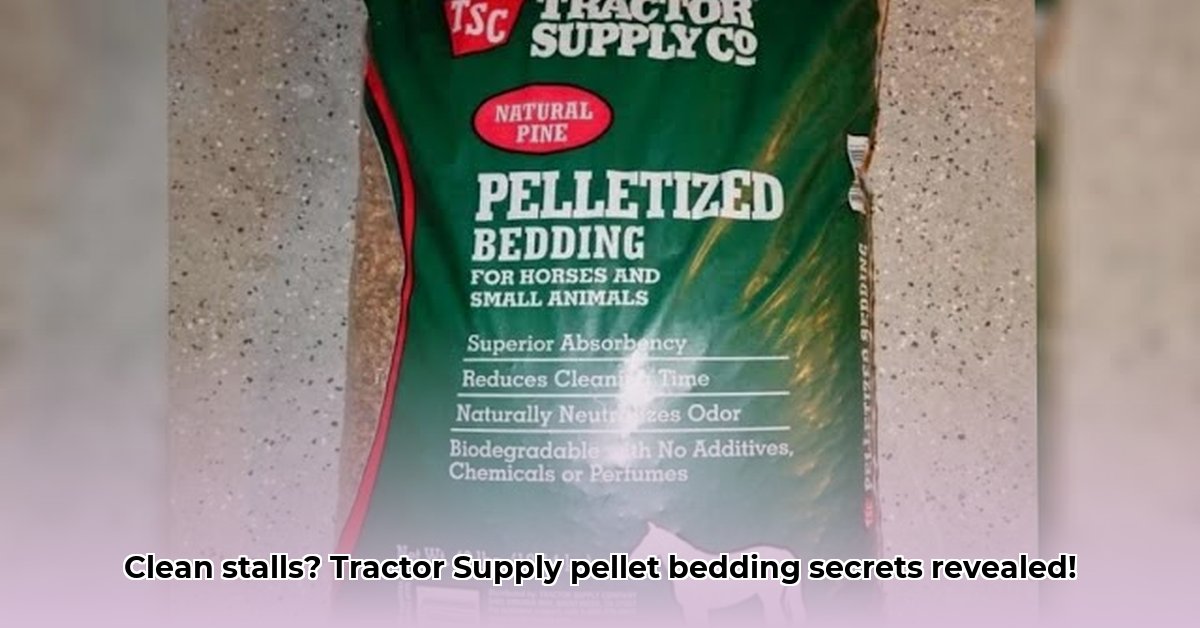
Why Choose Pellet Bedding for Your Horse?
Keeping your horse's stall clean, dry, and comfortable is crucial for their health and well-being. Traditional bedding options like straw and shavings often require frequent changes, leading to increased labor, waste, and potentially higher costs. Pellet bedding, readily available at Tractor Supply, presents a compelling alternative. But is it right for you and your horse? This guide will help you decide.
Advantages of Tractor Supply Pellet Bedding
Pellet bedding offers several significant advantages:
- Superior Absorbency: Many pellet beddings absorb four times their weight in liquid, resulting in drier stalls and less frequent changes. This translates to significant time and cost savings in the long run. Imagine the convenience of a stall that stays consistently dry and comfortable!
- Reduced Waste: The high absorbency of pellet bedding means less frequent cleanings and significantly less waste compared to traditional bedding materials. This is a win for both your wallet and the environment.
- Improved Hygiene: Drier stalls reduce the risk of bacterial and fungal growth, creating a healthier environment for your horse. This minimizes the potential for infections and promotes overall well-being.
- Dust Reduction (with the right choice): While some pellet beddings can create dust, many manufacturers now produce low-dust or dust-free options. Selecting one of these, combined with proper ventilation, is essential for horses with respiratory sensitivities.
Addressing Potential Drawbacks of Pellet Bedding
While the benefits are substantial, it's important to address potential downsides:
- Higher Initial Cost: The upfront cost of pellet bedding is typically higher than straw or shavings. However, the long-term cost savings due to reduced frequency of changes often outweighs this initial investment.
- Dust: As mentioned, dust can be a concern with some pellet beddings. Choosing a low-dust variety and ensuring adequate ventilation in the stall are crucial for mitigating this risk. "Selecting the right bedding is key," advises Dr. Emily Carter, DVM, Equine Veterinarian at the University of Kentucky.
Pellet Bedding vs. Traditional Bedding: A Comparison
Here's a head-to-head comparison to help you visualize the differences:
| Feature | Pellet Bedding (Tractor Supply) | Straw | Wood Shavings |
|---|---|---|---|
| Absorbency | Excellent (4x weight or more) | Moderate | Moderate |
| Waste Reduction | Substantially less | Low | Moderate |
| Dust | Variable (dust-free options available) | High | Moderate |
| Initial Cost | Higher upfront cost | Lower | Moderate |
| Long-Term Cost | Potentially lower overall | Higher | Moderate |
| Ease of Use | Relatively easy | Moderate | Moderate |
A Step-by-Step Guide to Using Pellet Bedding
Transitioning to pellet bedding is straightforward. Follow these steps for a smooth transition:
- Start Small: Begin by using pellets in a small section of the stall to observe your horse's reaction.
- Gradual Transition: Over several days, gradually increase the amount of pellet bedding until the entire stall is covered.
- Appropriate Amount: Use enough bedding to ensure adequate absorbency and comfort, adjusting based on your horse's size and activity level. Generally, aim for a depth of a few inches.
- Regular Spot Cleaning: Remove wet or soiled areas promptly to maintain hygiene and prevent odor build-up.
- Complete Stall Cleaning: Perform a thorough stall cleaning, removing all soiled bedding and manure, at regular intervals (frequency will vary depending on your horse's habits).
Sustainability Considerations: The Environmental Impact
For environmentally conscious horse owners, pellet bedding offers advantages. When sourced sustainably, it produces less waste than traditional options. Although the manufacturing process requires energy, the reduced transportation needs often offset this. "Choosing sustainably sourced pellet bedding contributes to responsible forestry practices," comments Professor David Miller, PhD, Environmental Science, Cornell University. However, selecting brands with certifications confirming sustainable sourcing is crucial.
Making the Right Choice for Your Horse
The ideal bedding depends on your horse's specific needs, your budget, and your environmental priorities. Consider the long-term costs versus initial expense. Discuss your options with your veterinarian for personalized advice tailored to your horse's health and any pre-existing conditions. Remember, the best bedding solution might evolve as new research emerges.